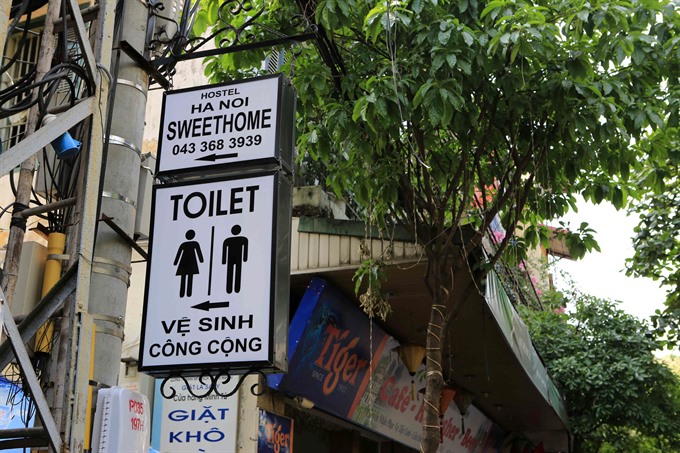 Op-Ed
Op-Ed

Microsoft co-founder and billionaire philanthropist Bill Gates delivered a rousing presentation on the revolution of toilets in China last week, but the thing that grabbed international headlines was the props he used to drive the point home: a clear canister of human excrement.
 |
| A signpost pointing to a public restroom on Hàng Giầy Street in the Old Quarter of Hà Nội. — VNS Photo Việt Thanh |
By Trọng Kiên
Microsoft co-founder and billionaire philanthropist Bill Gates delivered a presentation on toilets in China last week, but the thing that grabbed headlines was a prop he used: a clear canister of human excrement.
Even those unimpressed by the stunt couldn’t help but talk about it, which is probably a win for Gates, who has spent some of his fortune to raise awareness of sanitation and provide clean and working toilets in developing countries.
The story broke in Việt Nam to high praise, with most being impressed by the fact that a man of immense wealth was not shy from humbling himself to help the less advantaged.
The same week, the Việt Nam Toilet Association was launched by Vietnamese businessman, Lê Văn Hiệp – a long-time champion of proper latrines in Việt Nam – but despite the similar context, the reception was a mixed bag.
Many extolled his efforts to raise such a pressing, practical but ignored matter, while there were just as many panning the ‘smelly’ name and operation of the association, calling it a waste of money and time, insulting Hiệp and the association as perverts who enjoyed meddling with people’s private affairs, amongst other low-hanging jokes.
The direct manner of the man nicknamed ‘toilet knight,’ who said the establishment of the association would expedite the ‘toilet revolution’ and target 50-60 per cent sanitation coverage in Việt Nam, did not endear him to the public either.
Unabashed by the criticism, Hiệp told the media those uttering offensive comments had a backward mindset, expressing his desire to bring an unspeakable subject into the forefront of debate.
I have to applaud his audacity, given how excretion is taboo in all cultures, especially in a largely conservative Southeast Asian country like Việt Nam.
While it is true Vietnamese have only seen prosperity recently and there were other concerns in the past, the dismissive tight-lipped attitude, uncomfortable reactions and lack of genuine discussions on toilet issues didn’t help.
Ignoring the issue leads to a lack of toilets and poor maintenance of available ones, which results in public urination and mosquito-borne diseases, to name only two problems.
Then there are the ‘plop latrines’ in regions across Việt Nam. These latrines are located in fish breeding ponds, with the thinking being the animals scoop up the excrement but little of the horrendous infections.
According to the General Statistics Office, at least 20 per cent of the population still lack access to sanitary toilets, with only 65 per cent of rural residents having decent toilets.
The idea of sanitation impacting economic development might be laughable, but the World Toilet Organisation has said productivity losses due to these issues could cost countries as much as 5 per cent of their GDP. For Việt Nam, the loss is US$780 million a year from elevated threats of digestive illnesses.
Figures like that may get politicians’ attention.
Persistent pattern
Those who lived through the centralised economy, before the open-door policy in the late 80s, often mention bittersweet memories of privation that seem hard to imagine for those who only know of Việt Nam as one of the fastest-growing economies in the world.
I only learned of the horror of these trips to the loo through literary accounts.
Even in Hà Nội, during that time, a single house was divided into sections for multiple families who would squeeze into as little as 20sq.m and share a single toilet.
As common property, the toilet was used by all the occupants, yet no one was responsible for its upkeep, so over time, relieving oneself became an unpleasant experience that everyone tolerated and did nothing about.
More recently, my primary school offered one of the worst toilet experiences a student could imagine. The soaking wet floor, the stained tiles, the buzzing insects and having to flush the urinal/toilet with buckets of water drawn from nearby murky tanks.
To put this into context, my school was located in downtown Hà Nội and I attended in the early 2000s, so the toilets were a far cry from the modern equipment I have come to (sometimes) take for granted.
So overall, for Vietnamese, the toilet is not a priority, but a distant afterthought.
The mentality that it is beneath one to clean a toilet, or at least, keep it as clean as possible, doesn’t seem to have vanished, and this behaviour could undermine any amount of investment into new lavatories.
Fortunately, the issue has been given more attention in recent years, with the Government setting a target of putting an end to public urination by 2025, and have all households outfitted with standard toilets by 2030.
Minister of Health Nguyễn Thị Kim Tiến, in a recent report in front of the National Assembly, delivered this delicious soundbite: “Hospitals with dirty toilets mean that their directors are also dirty,” to urge the hospitals’ leaders to address the issue.
It’s not that I believe the Việt Nam toilet organisation can magic away the hang-ups Vietnamese have around this particular subject, but everything starts with a first step.
If Hiệp and his toilet association can convince people to pay attention to toilet issues, I say good for them. They have already stirred up debate and given the issue more exposure; that’s progress.
If he is able to push his company’s toilet products in the process, all the better. After all, the budget of the association comes from social funding, so society can decide if its money has been used wisely.
Five years ago, India touted the success of its space programme, as the first country in Asia to launch a satellite to Mars. Despite being a monumental achievement for a low-middle income country, the euphoria was dimmed by an irony many were quick to point out: Half of India’s rural population, which makes up 70 per cent of the South Asian country’s over 1 billion population, still defecate in the open, mostly due to a lack of latrines .
One year later, Indian Prime Minister Narenda Modi spearheaded the ambitious $20 billion ‘Clean India’ project, aiming to construct 111 million toilets for as cheap as $10 apiece by 2019 to “improve the health, safety and dignity” of millions of Indians.
However, critics have indicated building toilets should not be a singular goal but instead, the focus should be on changing habits and raising the awareness of millions of people, letting the vast number of rural residents know the health risks of open defecation.
Turning back to Việt Nam, with phrases like Industry 4.0 and digitalisation littered in all sectors’ agenda, probably it’s time to take a leaf from India’s book and wipe the nasty habits of bygone eras away. — VNS




